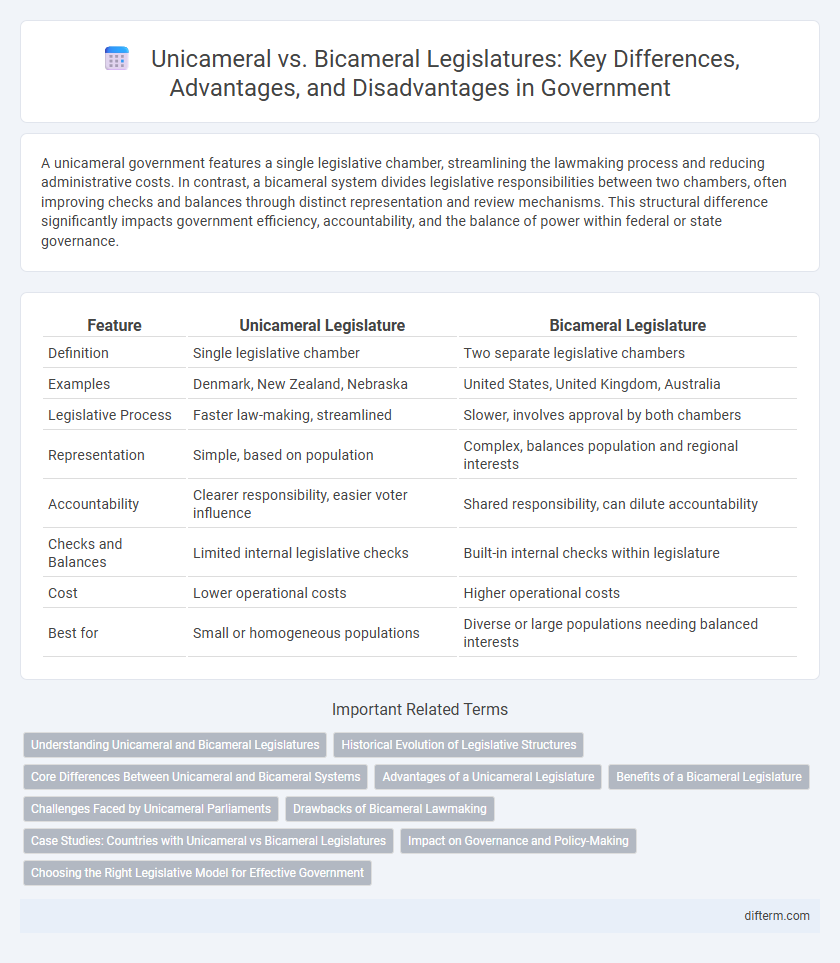A unicameral government features a single legislative chamber, streamlining the lawmaking process and reducing administrative costs. In contrast, a bicameral system divides legislative responsibilities between two chambers, often improving checks and balances through distinct representation and review mechanisms. This structural difference significantly impacts government efficiency, accountability, and the balance of power within federal or state governance.
Table of Comparison
| Feature | Unicameral Legislature | Bicameral Legislature |
|---|---|---|
| Definition | Single legislative chamber | Two separate legislative chambers |
| Examples | Denmark, New Zealand, Nebraska | United States, United Kingdom, Australia |
| Legislative Process | Faster law-making, streamlined | Slower, involves approval by both chambers |
| Representation | Simple, based on population | Complex, balances population and regional interests |
| Accountability | Clearer responsibility, easier voter influence | Shared responsibility, can dilute accountability |
| Checks and Balances | Limited internal legislative checks | Built-in internal checks within legislature |
| Cost | Lower operational costs | Higher operational costs |
| Best for | Small or homogeneous populations | Diverse or large populations needing balanced interests |
Understanding Unicameral and Bicameral Legislatures
Unicameral legislatures consist of a single legislative chamber, streamlining lawmaking and often allowing for faster decision-making processes. Bicameral legislatures feature two separate chambers, typically an upper house and a lower house, providing a system of checks and balances that enhances representation and deliberation. Understanding the structural differences between these systems is essential to evaluating their impact on governance, legislative efficiency, and democratic accountability.
Historical Evolution of Legislative Structures
The historical evolution of legislative structures showcases a gradual shift from unicameral to bicameral systems in many governments, reflecting the need for more balanced representation and checks on power. Early unicameral assemblies often gave way to bicameral legislatures as societies grew complex, incorporating upper houses to represent aristocracy or regional interests distinct from the lower house representing the general populace. This evolution underscores the role of bicameralism in enhancing deliberation, preventing legislative monopolies, and fostering a more nuanced lawmaking process rooted in diverse historical contexts.
Core Differences Between Unicameral and Bicameral Systems
Unicameral systems feature a single legislative chamber, streamlining lawmaking processes and enhancing efficiency in decision-making. Bicameral systems consist of two chambers, typically an upper and lower house, providing checks and balances that promote more thorough debate and representation of diverse interests. The core difference lies in the legislative structure's complexity, affecting how laws are proposed, reviewed, and enacted within different governance frameworks.
Advantages of a Unicameral Legislature
A unicameral legislature streamlines lawmaking by eliminating redundancy, which accelerates the legislative process and reduces governmental expenses. This system fosters greater transparency and accountability, as citizens can more easily track and influence a single legislative body. Countries with unicameral legislatures, such as Denmark and New Zealand, often experience more efficient governance and clearer policy outcomes.
Benefits of a Bicameral Legislature
A bicameral legislature offers enhanced checks and balances by dividing legislative responsibilities between two chambers, typically a lower house representing the population and an upper house providing regional or state representation. This structure promotes more thorough scrutiny of laws, reducing the risk of hasty or ill-considered legislation through dual approval processes. Countries such as the United States and India benefit from bicameral systems by ensuring diverse interests are balanced, fostering stability and comprehensive governance.
Challenges Faced by Unicameral Parliaments
Unicameral parliaments often face challenges such as limited checks and balances, which can increase the risk of hasty or poorly scrutinized legislation. The absence of a second chamber reduces opportunities for diverse representation and regional interests, potentially leading to centralization of power. This structure may also struggle with ensuring adequate debate and slowing down legislative processes needed for thorough policy evaluation.
Drawbacks of Bicameral Lawmaking
Bicameral lawmaking often leads to legislative gridlock, as conflicting interests between the two chambers delay decision-making and reduce efficiency. This system can increase the complexity and cost of passing laws, requiring prolonged negotiations and compromises that may dilute policy effectiveness. Furthermore, bicameral legislatures risk over-representation of certain groups, potentially undermining equitable democratic representation.
Case Studies: Countries with Unicameral vs Bicameral Legislatures
Sweden exemplifies a successful unicameral legislature, streamlining legislative processes and enhancing government efficiency through its single-chamber Riksdag. In contrast, the United States operates a bicameral system with the House of Representatives and the Senate, promoting checks and balances and representing diverse regional interests while often resulting in slower legislative deliberations. Comparative analysis reveals unicameral systems favor legislative speed and cost-effectiveness, whereas bicameral systems emphasize representation and oversight, impacting governance structures worldwide.
Impact on Governance and Policy-Making
Unicameral legislatures streamline governance by enabling faster decision-making and reducing legislative gridlock, which can lead to more efficient policy implementation. Bicameral systems provide a built-in system of checks and balances, promoting thorough debate and preventing rash decisions but often result in slower legislative processes. The choice between unicameral and bicameral structures directly affects the balance between efficiency and representational oversight in policymaking.
Choosing the Right Legislative Model for Effective Government
Selecting a unicameral or bicameral legislative model depends on factors such as governance efficiency, representation diversity, and decision-making speed. Unicameral systems streamline lawmaking by having a single legislative body, which enhances accountability and reduces legislative gridlock. Bicameral legislatures provide checks and balances through two chambers, ensuring broader representation and preventing hasty legislation, vital for complex or federal governments.
unicameral vs bicameral Infographic

 difterm.com
difterm.com